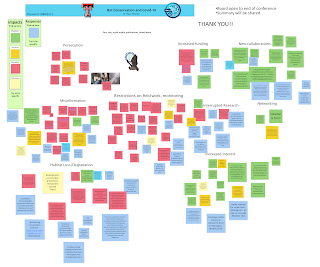Scientific perceptions of bat conservation and COVID-19: Insights from the International Berlin Bat Meeting 2021
Abby Rutrough, Tigga Kingston & Susan M. Tsang
 |
|
We used a Miro online collaboration board to facilitate virtual participation from attendees to solicit broad impact categories regarding bat conservation and COVID-19. Nine generally self-explanatory categories were identified (see Figure 1 Miro Board below). For example, Habitat Loss and Degradation referred to changes in disturbance patterns caused by the pandemic and concerns over roost monitoring and protection (especially on private lands) while Increased Awareness encompassed public interest, press interest, and research interest. We then collected comments and observations from attendees on the impact of COVID-19 on bat conservation within these broad impact categories using virtual sticky notes. The sticky notes were separated into positive, negative, neutral, and unknown impacts and attendees could move their stickies to reflect the category they deemed the best fit. Later in the talk, we asked attendees for responses or solutions to the challenges laid out in the impact stickies.
The board was left open for an additional 48 hours until the end of the conference to allow for further contributions from attendees, including those who could not attend the event live.
 |
Figure 1. Miro Collaboration Board generated by attendees of the 6th International Berlin Bat Meeting Keynote: Bat conservation and COVID-19, March 22 2021. Colors indicate positive (green), negative (red), neutral (yellow), unknown (cream) impacts as well as responses/solutions (blue). Click here to enlarge to full size and read responses.
|
At its peak, the board had over 150 participants, with additional participants attending the keynote and contributing via the conference chat. Conference participants represented at least 39 countries across multiple continents and were primarily drawn from research and conservation backgrounds.
What were some of the take home messages from the Miro Board session?
- Lots of negatives but positives point to an optimistic future
Overall, we collected 91 impact notes and 43 solution notes. The number and type of impacts varied widely between categories. Participants consistently believed the COVID-19 pandemic negatively impacted activities classified as “Persecution” or “Restrictions on Fieldwork and Monitoring” while they perceived positive impacts on “New Collaborations,” “Networking,” and “Increased Interest” were overwhelmingly positive. - People are ubiquitous but so is fear
The broadest patterns throughout the board were people and fear, while collaboration frequently appeared in positive comments. COVID-19 has opened many opportunities for virtual collaboration across disciplines and time zones as highlighted by the high participation in creating this board. - Fear is overwhelming the positive messages
Figure 4. Word cloud of all sticky notes classified as misinformation. Fear was mentioned so often it drowned out the positive messages.
Misinformation: Participants contributed ten negative, two neutral, three positive, and one unknown impact of misinformation. Fear was a repeated concern reported by participants working with the general public:
“We experienced fear from church communities about bats in the church. We also had some cases of churches wanting to fumigate (not to impact the bats but to ‘protect’ people)”
Other negative impacts focused on the changing public perceptions towards bats. These increased negative perceptions were reported in published literature (here and here), in personal observations of public attitudes, and in political arguments against bat conservation due to the economic cost of the pandemic.
Positive impacts of the pandemic centered around the platform it has given scientists to speak to the public about bats and direct positive experiences with curious members of the public. However, it should be noted that at least one participant has struggled in with combating misinformation:“Whilst I would be happy informing people / combating misinformation… even after receiving the facts, some people still do not care (have other priorities) or are irrationally fearful… How can we deal with that?”
These sentiments are likely shared by other members of the bat research community. Increasing resources and seeking out training on media and public communication would be valuable to scientists aiming to contribute to the fight against misinformation.
- Lots of persecutions, few solutions
Of the nine sticky notes related to persecution, eight were classified as negative and one was neutral. None were positive and there were no responses from the community on how to address persecution moving forward. Participants noted both individual and government persecution of bats related to their perceived disease risk. These actions included cutting down roost trees, fumigation of buildings, roof removal to evict bats, and the burning of a bat-box. However, public concern also extended to protecting bats:
“[A] Roost owner got in touch with our helpline for advice as they were worried people would attack their roost if they found out about it due to fear headlines in the news”
- Positive comments: Increased interest, increased opportunities
There were twenty-five ongoing or completed positive impacts from across all COVID-19 impact categories. Increased interest contributed to the most, with ten sticky notes; followed by new collaborations with seven; misinformation and networking each with two; interrupted research, habitat loss and degradation, and increased funding with one each; while persecution and restrictions on fieldwork and monitoring had zero positive impacts reported by participants.
The most prominent positive impact was the increased global and interdisciplinary collaborations formed in response to the COVID-19 pandemic, including the formation of the Global Union of Bat Diversity Networks (GBatNet).
“Huge interest in new collaborations with Broad, Singapore, UK, US… has led to many integrative papers and funding applications”
“Bat genomes published with huge international press e.g. BBC highlighting how bats are essential for ecosystems, understanding immune tolerance, longevity etc.”
Though participants were consistently concerned about media attention and its impact on long term bat conservation, many also saw this increased attention as an opportunity to raise awareness of bat conservation issues.
“…mainstream press pieces used covid/disease as news hook but did pivot to positive messages on bats (example CNN special in June, PBS Newshour recently)”
A few participants also noted the temporary decrease in human disturbance in some areas due to lockdown restrictions and the increased interest from students in bat research.
- Reach out, communicate, and work together
Figure 7. Word cloud of all sticky notes classified as solutions. Broad solutions largely focused on research, collaboration, and communication with the public and media.
Participants coalesced on solutions that involved increased research to further understanding of bats, often involving interdisciplinary collaboration, and branching out to increase the quantity and quality of scientists’ communication with the media and the public.
“Outreach should aim to break out of echo chambers and we should put effort into engaging new / negative groups. This links with networking and collaboration with new and very different sectors”
Within “Restrictions on Fieldwork and Monitoring,” solutions emphasize developing better understanding of different field methods to minimize risk. Many noted the importance of guidance on bat handling and creating a better culture of field hygiene in bat research.
“Maintaining guidance and keeping current with good comms between virologists and bat workers.”
“IUCN Guidelines for safe bat handling are VERY helpful for setting standards”
- People are the problem and the solution
We would like to highlight the central role people played throughout the board. In both positive and negative impacts, as well as proposed solutions, people and the public were consistently one of the most prominent themes. As the COVID-19 pandemic continues, it is critical for the scientific community to continue sharing both new challenges and effective solutions as they arise.






